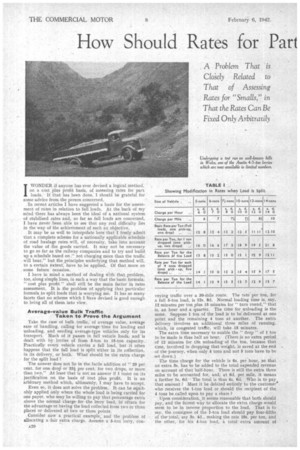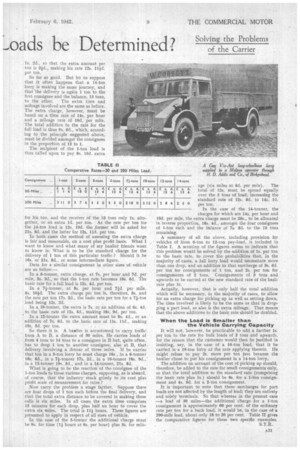How Should Rates for Part loads be Determined?
Page 22

Page 23

If you've noticed an error in this article please click here to report it so we can fix it.
.
IWONDER if anyone has ever devised a logical method, on a cost plus profit basis, of assessing rates for part loads. If that has been done,' I should be grateful for some advice from.the person concerned,
In recent articles I have suggested a basis for the assessment of rates in relation to full loads. At the back of my mind there has always been the ideal of a national system of stabilized rates and, so far as full loads are concerned, I have never been able to see that any real difficulty lies in the way of the achievement of such an objective.
It may be as well to interpolate here. that I freely admit that a complete scheme for a nationally applicable schedule of road haulage rates.will, of necessity, take into account the value of the goods carried. It may not be necessary to go so far as the railway companies and to try and build up a schedule based on." not charging more than the traffic will bear," but the principles underlying that method will, to a -certain extent, have to be applied. Of that more on some future occasion.
I have in mind a method of dealin.,c. With that problem, too, along simple lines, in such a way that the basic formula: " cost plus profit" shall still be the main factor in rates assessment. It is the problem of applying that particular formula to split loads that is worrying me. It has so many facets that no scheme which I have devised is good enough to bring all of them. into view,
Average-value Bulk Traffic Taken to Prove the Argument
Take the case of hulk traffic, of average value, average ease of handling, calling for average time for loading and unloading, and needing average-type vehicles only for its transport. ' Much of it passes in full vehicle Toads, and is dealt with by lorries of from 5-ton to 15-ton capacity. Practically every vehicle carries a full load, but it often happens that the full load is split either in its collection,in its delivery, or both. What-should be the extra charge
for the split load ? .
The answer does not lie in the facile addition of " 20 pt-r cent, for one drop or 33/ per cent, for two drops, or more than two." At least that is not an answer if I insist on its justification on the basis of -cost plus profit. It is an arbitrary method which, ultimately, I may have to accept. Even so, it does not solve the problem; It can be equitably applied only where the whole-load is being carried for one payer, who may be willing to pay that percentage extia above the normal charge for the lorry load, in return for the advantage ot having the load collected from two or three places or delivered at two or three. points.
Consider now a practical example, and the problem of allocathig a •fair extra charge. Assume a 5-ton lorry, Con A20 . veying traffic over a 30-mile route. The rate per ton, for a -full 5-ton load, is 12s. 8d. Normal loading time is, say, 12 minutes per ton plus 15 minutes for " turn round,' that is, an hour and a quarter. The time for unloading is the same. Suppose 1 ton of the load is to be delivered at one point and the remaining 4 tons at another. The extra delivery involves an additional three miles of running, which, in congested traffic, will take-IS minutes, The extra time necessary to enable the " drop " of 1 ton to be made is thus half an hour, (There is no extra period. of 12 minutes for We unloading of the ton, because that time, involved in dropping that weight, is saved at the end of the journey, when only 4 tons and not 5 tons have to be set down.)
The time charge for the vehicle is fis. per hour, so that an extra 3s. has to be added to the total expended revenue QI1 account of that half-hour. There is still the extra three miles to be accounted for, and, at fid. per mile, it means a further is. 6i1.• The total is thus 4s. 6d. Who is to pay. that amount ? Must it be debited entirely to the customer who receives the 1-ton load or should the recipient of the 4 tons be called upon to pay a share ?
Upon consideration, it seems reasonable that both should pay, and the fairest way to allocate the eittra charge mould seem to he in inverse proportion to the load. That is to say, the consignee of the 1-ton load should pay four-fifths of the total, say Sc. 4a., making the rate 16s. per ton, and the other, for •hi s 4-ton load, a total extra amount of
is. 2d., so that the extra amount per ton is 30., making his rate I2s. 110. per .ton.
So far so good. But let us suppose that it often happens that a 14-ton lorry is making the same journey, and that "the delivery is again I ton to the first consignee and the balance, 13 tons,
to the other. The extra time and mileage involved are the same as before. The extra charge, however, must be based on a time rate of 14s. per hour and a mileage rate of •I0d. per mile. The total addition to the rate for the lull load is thus 9s, 6(1., which, accord:. ing to the principle suggested above, must be divided amongst the consignees in the proportion of 13 to 1.
The recipient of the 1-ton load is thus called upon to pay Ss. 10d. extra for his ton, and the receiver of the 13 tons only le. altogether, or an extra Id. per ton. As the rate per ton for the .I4-ton load is 12s. 10d. the ,former will be asked for 21s. Sd. and the latter for 12s, 11d. per ton.
In both cases the method of assessing the extra charge is fair and reasonable, on a cost plus profit basis. What I want to know and what many of my haulier friends want to know is: What is to be the standard charge for the delivery of 1 ton of this particular traffic ? Should it be 16s. or 21s. Bd., or some intermediate figure.
Data for a similat consignment in other sizes of vehicle are as follow; In a 6-tonner, extra charge, at 7s, per hour and 7d. per mile, 5s. 3d., so that the 1-ton rate becomes 16s, 6d. The basic rate for a full load is 12s. 4d, per ton.
In a 7i-tormer, at Sc. per hour and 7id. per mile, 5s. lOid, The extra charge per ton is, therefore, 5s. and the rate per ton 17s. 2d., the basic rate per ton for a 7i-ton load being 12s, 2d.
In ai lb-tanner, the extra is 7s. or an addition of 6s. 4d. to the basic rate of 12s, 50., making 18s. 9d. per ton.
In a 12-tonner the extra amount must be Ss, 4d., or an addition of 7s. 6d. to the basic rate of 11g. 11d., making 195. sa. per ton.
So there it is. A haelier is accustomed to carry traffic from A to B, a distance of 30 "miles, He carries loads of from 4 tons to 14 tons to a consignee in B but, quite often, has to drop 1 ton to another consignee, also at B, that delivery involving a detour of three miles. If he carries that ton in a 5-ton lorry he must charge 16s.,. in a 6-tonner 16s. 6d., in a 7i-tonner 17s. 20., in a 10-tonner 18s. 9d., in a 12-tonner 19s..5d., and in a 14-tonner, 21s. 8d. .
What is going to be the reaction of the consignee of the 1-ton loads to these various charges, supposing, as is absurd, of course, that the industry, stuck grimly to its cost plus profit scale of measurement for rates ?
Now carry the problem a stage faither. Suppose there are four drops of 1 ton each before the final delivery, and • that the total extra distance to be covered in making these calls is six miles, In all cases the extra time comprises 15 minutes for each drop, plus half an hour to cover the extra six miles. The total is 14 hours. These figures are presumed to apply in respect of all sizes of vehicle.
In the case of the 5-tanner the additional charge must be 9s. for time hours at 6s. per hour) plus 3s. for mile age (six miles at 6d. per mile). The
total of 125. must be spread equally over the 5 tons of load, increasing the standard rate of 12s. Bd. to 14s. id. per ton.
In the case of the 14-tonner, the charges for which are 145, per hour and 100. per mile, the extra charge must be 26s., to be allocated in inverse proportion, 18s. 4d., amongst the four consignees of 1-ton each and the balance of 7s. 8d. to the 10 tons remaining.
A summary of all the above, including provisionfor vehicles of from 6-ton to 12-ton pay-load, is included in . Table L A scrutiny of the figures seems to indicate that this problem would be solved"by the addition of ls, per ton to the basic rate, to cover the probabilities that, in the 'majority of cases, a lull lorry load would necessitate more than one drop, and an addition to that surcharge of 3s. 6d, per ton for consignments of 1 ton, and 2s, per ton for consignments of 2 tons. Consignments of 3 tons and upwards to be carried at the new standard rate of the basic rate plus Is.
Actually, however, that is only half •the total addition which will be necessary, in the majority of cases, to allow for an extra charge for picking up as well as setting down. The time involved is likely to be the same as that in dropping a part load, as also is the extra mileage. That means that the above additions to the basic rate should be doubled.
• • •
When the Load is Smaller than
the Vehicle Carrying Capacity
It will not, however, be practicable to add a further Is. per ton to the rate for bulk loads of 3 tons and upwards, for the-reason that the customer would then he justified in insisting, say, in the case of a 10-ton load, that it be carried in a 10-ton lorry at the rate applying thereto. He might refuse to pay 2s. more per ton just because the haulier chose to put his consignment in a 14-ton. lorry.
The addition on account of the cost of picking up should. therefore, be added to the rate for small consignments only, so that the total addition to the standard rate (comprising the basic rate plus Is.) should be 8s.-for a 1-ton consignment and 4s. 6d. for a 2-ton consignment.
It is important to note that these surcharges for part loads are not affected by the length of lead; they are entirely and solely terminals. So that whereas in the present case -a lead of 30 miles-the additional charge for a 1"-ton consignment is approximately 60 per cent, of the ordinary rate per ton for a back load, it would be, in the case of a 200-mile lead, about only 18 to 20 per cent. Table II gives the comparative figures for these two specific examples.




















































